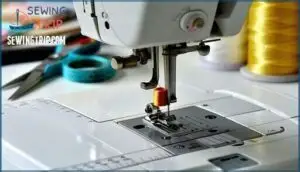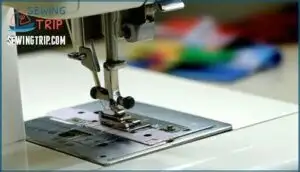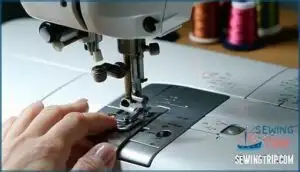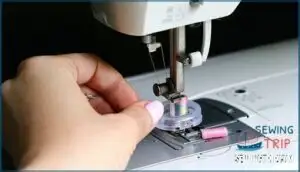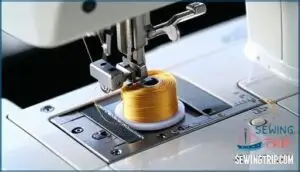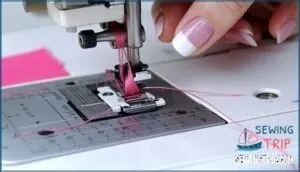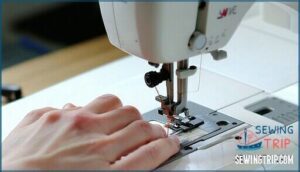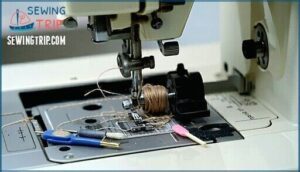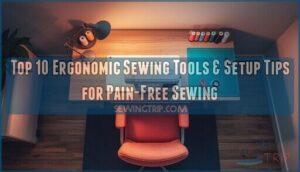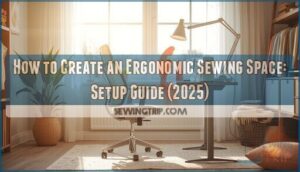This site is supported by our readers. We may earn a commission, at no cost to you, if you purchase through links.
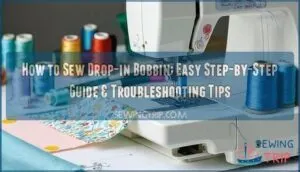 Some sewing problems feel like they were designed by pranksters: tangled threads, mystery jams, and that sinking feeling when your project grinds to a halt. The culprit? Often it’s the bobbin, hiding in plain sight under the needle.
Some sewing problems feel like they were designed by pranksters: tangled threads, mystery jams, and that sinking feeling when your project grinds to a halt. The culprit? Often it’s the bobbin, hiding in plain sight under the needle.
If you’ve ever wondered why drop-in bobbin systems earn such loyal fans, you’re about to see the secret. A well-loaded drop-in bobbin turns machine sewing from a headache into something almost magical—smooth, steady, and reliable.
Ready to take charge of how to sew drop in bobbin and keep your projects rolling? Let’s clear the confusion and make your next stitch frustration-free.
Table Of Contents
Key Takeaways
Drop-in bobbin systems make sewing easier and faster by offering simple installation, clear thread visibility, and fewer jams—perfect for beginners and pros alike.
Always insert the bobbin so the thread unwinds counterclockwise, and double-check it’s seated correctly to keep your stitches smooth and tension steady.
Regular cleaning and maintenance—like removing lint and checking for worn parts—are key to preventing thread jams and keeping your machine running well.
Using the right bobbin size, compatible threads, and avoiding metal bobbins in plastic cases helps protect your machine and ensures reliable sewing results.
What is a Drop-in Bobbin System?
If you’re new to sewing machines, you’ve probably heard about drop-in bobbins. They’re a popular choice for many sewists and make threading a breeze.
Let’s look at what makes this system tick and see how it compares to other options.
How a Drop-in Bobbin Works
Once you’ve got your Top Dropin Bobbin in hand, correct insertion is key. Drop it in, making sure bobbin rotation goes counterclockwise—this helps with bobbin tension and smooth thread flow.
The bobbin case keeps everything tidy, and good bobbin management means fewer hiccups. Regular maintenance schedule checks keep your dropin bobbin working with all sorts of material compatibility.
Drop-in Vs. Front-Load Bobbins
Now, let’s stack up the Top Dropin Bobbin against its frontloading cousin. Dropin bobbins win for Loading Ease and Visibility—just pop the bobbin in and keep an eye on your thread. Frontloaders shine with Thread Capacity and Bobbin Tension Adjustment, making them the go-to for heavy-duty work or tricky threads.
Machine Speed? Frontloaders take the lead! The shuttle moves the top thread around the bobbin case, picking up the bobbin thread to form a stitch.
Common Drop-in Bobbin Sewing Machines
So, after sizing up front-loaders, you’re probably itching to know which sewing machine brands nail the drop-in bobbin game. Here’s a quick look:
- Singer 4423—Beginner-friendly
- Brother XR9550—Material compatibility galore
- Janome Skyline S7—Sophisticated features
- Bernina 435—Jumbo bobbin sizes
- Singer Quantum Stylist 9960—Easy bobbin installation
These machines also include helpful features like automatic needle threaders to simplify sewing. Each one makes sewing machine troubleshooting a breeze!
Benefits of Using Drop-in Bobbins
Drop-in bobbins make sewing feel a lot easier, no matter your experience level. They offer some real perks that can save you time and hassle. Here’s what you’ll notice when you use them.
Time-Saving and Efficiency
If you’re tired of fiddling with tricky bobbin cases, drop-in bobbins are like hitting the fast-forward button on your sewing routine. Quick Bobbin Changes mean less downtime and more sewing. Optimized Threading keeps your workflow efficient, while simplified projects let you focus on creativity.
With easy bobbin installation, Bobbin Management Techniques, and fewer tension issues, your sewing machine becomes a true time-saver.
Ease of Use for Beginners
Honestly, you’ll almost always feel like a pro right from the start when you use a drop-in bobbin system—it’s that beginner-friendly! Simple threading and quick setup mean you can dive into beginner projects without a hitch.
With a drop-in bobbin system, even beginners feel instantly confident thanks to its simple threading and quick setup
The user-friendly design boosts your Sewing Machine Confidence, while easy maintenance and clear Bobbin Installation Guides keep those nerves at bay.
Enhanced Thread Visibility and Fewer Jams
Clarity is your best friend with a drop-in bobbin system, making it easy to spot thread issues before they turn into a tangled mess. Thanks to Clear Bobbin Covers, you’ll see your thread management in action—no surprises.
Consistent Threading and Proper Machine Setup help prevent jams. Regular Bobbin Case Maintenance and attention to Thread Quality Matters mean fewer headaches and smoother sewing.
How to Load a Drop-in Bobbin
Getting your drop-in bobbin loaded the right way makes sewing smoother from the start.
Here’s what you’ll need to do before you begin stitching. Let’s walk through each step together.
Lifting The Presser Foot and Needle
Ready to get started? The first move is like setting the stage for your sewing adventure—lift the presser foot and needle to give your bobbin a clear runway! Why do this? Here’s what you make available:
- Foot Lever Position
- Needle Height Adjustment
- Fabric Release Ease
- Tension Disc Release
- Thread Slack Control
It’s a simple step, but essential for smooth threading!
Opening The Bobbin Cover Plate
Ever feel like a magician revealing a secret compartment? That’s exactly what it’s like when you open your bobbin cover plate! Find the release button location—each sewing machine has its quirks. Some cover plate types slide, others pop up.
If it’s jammed, don’t force it; clean the plate area first. Knowing your releasing mechanisms makes Sewing Machine Troubleshooting a breeze.
Removing The Empty Bobbin
Think of this step as swapping out a spent battery—removing the empty bobbin keeps your sewing running smooth and steady. Gently lift the bobbin from its case, watching for any jammed bobbin removal issues. Check the thread tail length before tossing. While you’re at it, peek at the bobbin thread tension and give the bobbin area a quick clean.
- Bobbin case access is key—don’t force it!
- If the bobbin’s jammed, clear any lint or tangled threads.
- Short thread tails can cause snags; keep them tidy.
- Cleaning the bobbin area now prevents future hiccups.
Inserting The New Bobbin Correctly
Sliding in a fresh bobbin is a bit like putting the last piece in a puzzle—if it fits just right, your sewing will run smooth as butter. Make sure you’re using the correct bobbin size for your sewing machine. Drop it in, secure its placement, and double-check it’s seated properly. This sets up smooth thread flow and keeps your tension system happy.
Checking Bobbin Thread Direction
Now that your bobbin’s sitting pretty, let’s make sure the thread’s headed in the right direction for a smooth stitch.
Here’s your quick check:
- Confirm Rotation Direction—thread should unwind counterclockwise.
- Do a Visual Inspection for proper placement.
- Watch for Tension Impact—thread tension matters!
- Double-check bobbin tension before starting your threading process.
Threading and Pulling Up The Bobbin Thread
Now that your bobbin’s loaded, it’s time to get that thread ready for sewing. This next part is all about guiding the thread and pulling it up just right. Here’s what you’ll need to do.
Guiding Thread Through Notches and Tension Slots
Make sure you follow the threading order—it matters! Slide your thread along the notch thread path, slipping it into the tension slot function so your bobbin tension stays just right. Aim for a suitable thread angle to avoid thread tangles.
The threading process here is all about Thread Tension Control, making your stitches neat and your sewing headache-free.
Pulling The Bobbin Thread Up With The Needle
Once your thread is tucked snugly into those tension slots, it’s time for a little sewing magic—let’s get that bobbin thread up where you can see it. Turn your hand wheel toward you, watching as the needle dips and catches the bobbin. You’ll see both threads pop through, ready for action!
- Feel that rush of accomplishment
- Celebrate perfect needle thread tension
- Wave goodbye to hook timing issues
Troubleshooting Drop-in Bobbin Issues
Even the best sewing machines can throw you a curveball now and then. If your drop-in bobbin starts acting up, don’t worry—you’re not alone. Here’s what you’ll want to check next.
Bobbin Thread Tension Problems
Is your stitch quality looking a bit wild? You might be wrestling with thread tension! Tension adjustment depends on thread weight, bobbin case condition, and lint buildup. A quick check and clean can work wonders.
Here’s a handy table to spot trouble:
| Problem | Cause | Quick Fix |
|---|---|---|
| Loops | Loose tension | Tighten screw |
| Puckering | Tight tension | Loosen screw |
| Knots | Lint buildup | Clean bobbin case |
Bobbin Jams and Misfeeds
From tangled threads to sudden stops, bobbin jams can make you want to throw your sewing machine out the window! Here’s what might be causing trouble:
- Lint Accumulation in the bobbin case
- Threading Errors along the path
- Bobbin Wear after years of use
- Improper Winding causing slack
- Repair Costs that creep up with repeated jams
Maintenance Tips for Smooth Operation
If you want your sewing machine to hum along happily, a little regular TLC goes a long way. Cleaning lint from bobbin areas, oiling mechanisms, and checking tension keep sewing machine parts in top shape.
Swap out dull needles, manage thread properly, and consider regular servicing for peace of mind. Good sewing machine maintenance beats sewing machine repair any day!
When to Replace Your Bobbin or Case
Every so often, you’ll notice your stitches acting up or your machine sounding a little cranky, and that’s your cue to check if your bobbin or its case needs a fresh start.
Watch for bobbin wear signs
- Watch for bobbin wear signs
- Spot case damage indicators
- Notice material degradation impact
- Sense sewing quality decline
- Follow a replacement frequency guide
Frequently Asked Questions (FAQs)
How do I adjust the tension for a drop-in bobbin system?
Find the tension dial guide, turn it slightly, and take note of the fabric type impact—different fabrics react in unique ways.
Use the test stitch method, watch for common tension errors, and reread professional adjustment tips for perfect thread management.
How do I clean the drop-in bobbin area?
Slide off the bobbin cover plate, then use a small brush for lint removal around the bobbin and sewing machine parts.
Apply a tiny bit of oil to the mechanism, skip harsh solvent application, and practice preventative measures for sewing machine maintenance.
Can you use pre-wound bobbins in drop-in systems?
Imagine this: You grab a pre-wound bobbin for your drop-in system—so convenient! Just check bobbin compatibility, thread types, and tension adjustments.
Sometimes winding your own bobbin works better for Sewing Machine Maintenance and smooth stitching.
What types of thread work best with drop-in bobbins?
Cotton and polyester threads in medium thread weight work best with drop-in bobbins.
For embroidery, wooly nylon offers great stretch.
Check your bobbin material, thread finish, and spool size for smooth thread management and fabric and thread selection.
Is it safe to use metal bobbins in plastic cases?
Metal bobbins in plastic cases can cause Bobbin Damage or Machine Wear over time. Material Compatibility matters—mixing types may affect Thread Tension and lead to Safety Concerns. Always check your sewing machine accessories guide for the right bobbin.
How do you clean lint around the drop-in bobbin area?
Think of lint buildup like dust gathering under your bed—it creeps up fast! Use cleaning tools like a small brush or tweezers, practice preventative measures, and increase cleaning frequency to avoid machine damage and keep your sewing techniques sharp.
Can decorative stitches affect drop-in bobbin performance?
Decorative stitches can impact drop-in bobbin performance, especially with high stitch density or heavy thread weight.
Watch your bobbin tension, needle choice, and fabric type—these sewing techniques all play a role in smooth stitching on your sewing machine.
Conclusion
Picture your sewing machine as a trusty ship, and the drop-in bobbin is its anchor—steady, reliable, keeping every stitch on course. Mastering how to sew with a drop-in bobbin means you’re the captain, steering clear of tangled seas and sudden storms.
Each project becomes a smooth voyage, with fewer detours and more creative freedom. Now, with your bobbin loaded just right, you’re set to explore new patterns, confident your sewing journey will always stay afloat.
- http://mailto:hello?subject=SIA%20Question
- https://en.wikipedia.org/wiki/Rotary_hook
- https://hobbycouture.com/en/a/how-does-a-sewing-machine-work
- https://www.facebook.com/groups/cucicucicoocreations/
- https://maggieframestore.com/es/blogs/maggieframe-noticias/ultimate-guide-to-front-load-bobbin-systems-mastering-installation-mechanics-troubleshooting

